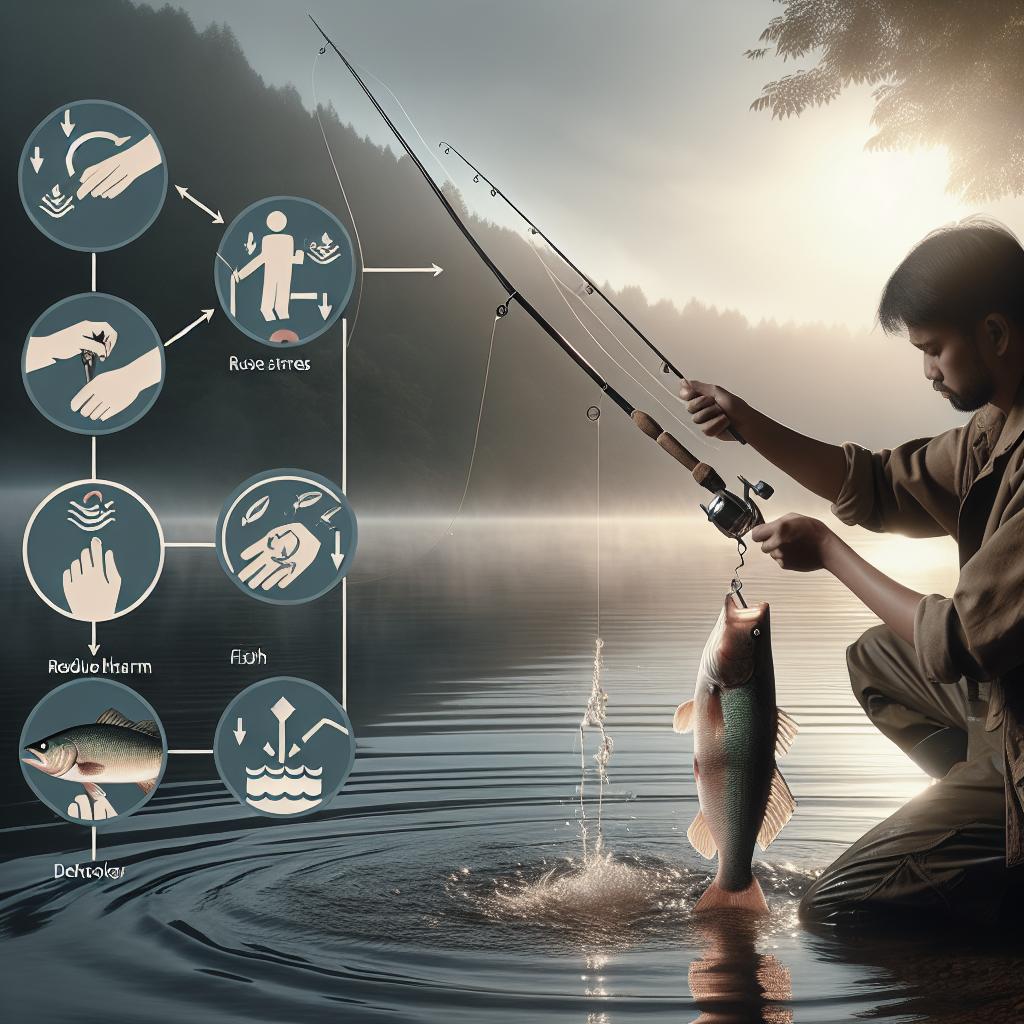“`html
Executive summary
Catch and release is a conservation practice embraced by anglers to ensure the sustainability of fish populations. This article delves into key strategies and guidelines on how to practice catch and release effectively. We will explore various influencing variables such as physiological responses, hook types, choice of bait, and other critical factors. Additionally, guidelines on proper angling techniques, handling, and revival of fish are provided. This comprehensive guide aims at enhancing awareness and implementation of ethical fishing practices to benefit both the environment and future angling experiences.
Introduction
Practicing catch and release is essential for maintaining fish populations and ensuring sustainable fishing opportunities. With a focus on reducing fish mortality, this blog post explores various factors that influence the effectiveness of catch and release. We’ll cover physiological responses, types of hooks, and other key factors that contribute to the success of this practice. Furthermore, we provide practical guidelines for anglers to follow in order to minimize harm to fish and enhance post-release survival rates. By implementing these strategies, anglers can enjoy their passion while promoting the long-term health of aquatic environments.
Influencing variables for effective catch-and-release
Physiological response
The physiological response of fish to catch and release is a major factor influencing their survival post-release. When fish are caught, they experience stress that can affect their blood chemistry, reduce resilience, and increase vulnerability to predators. Key stressors include physical exertion, air exposure, and handling. Understanding these stress responses is crucial in minimizing their impact.
Research shows that quick retrieval and gentle handling can reduce the physiological stress on fish. Anglers should aim to release fish in a timely manner to enhance their chances of recovery. Furthermore, considering the fish’s physical condition and behavior can provide insights into their stress levels, enabling more informed handling decisions.
Hook type
The choice of hook significantly affects fish survival chances. Single barbless hooks are recommended as they are easier to remove and less likely to cause injury. Barbed hooks can cause deep wounds and increase the time required for removal, thereby elevating stress and potential damage to the fish.
Circle hooks are also favored for catch-and-release due to their design, which typically hooks fish in the corner of the mouth, minimizing internal damage. Choosing the right hook type is essential in minimizing mortality rates and ensuring that fish have a higher likelihood of surviving post-release.
Live vs. artificial baits
Live bait often leads to deeper hooking compared to artificial lures, which can increase the stress and injury experienced by the fish. This can result in lower survival rates upon release. Using artificial baits can help reduce the chances of deep ingestion, making them a more conservation-friendly choice for catch-and-release practices.
On the other hand, certain artificial lures can also cause external damage. Therefore, choosing baits that mimic natural prey with minimized risk of harm is vital. Evaluating the type of bait used is an important consideration in enhancing the success of catch-and-release efforts.
Hooking location
Where a fish is hooked plays a critical role in its survival upon release. Fish hooked in the lip, jaw, or corner of the mouth generally have better survival rates compared to those hooked in the gills or gut. Proper hook selection and angling technique can help ensure more favorable hooking locations.
Quickly setting the hook can prevent deep hooking, which is associated with higher mortality. Monitoring how and where fish are hooked during the angling process can substantially improve their chances of surviving after release.
Bleeding
Bleeding indicates significant injury and is a crucial predictor of post-release mortality. Fish that are bleeding heavily, particularly from the gills or vital organs, have reduced chances of survival. Minimizing deep hooking and rough handling can reduce the risk of bleeding.
Anglers should prioritize minimizing damage to the fish and avoiding unnecessary injury during catch-and-release. This involves choosing the right equipment and adopting a gentle handling approach to lower the risk of bleeding and increase survival probabilities.
Depth of capture
The depth at which a fish is captured can influence its physiological condition upon surfacing. Fish brought up from deep waters may experience barotrauma due to rapid pressure changes, which can impair their ability to swim and recover post-release.
Using proper angling techniques like slow retrieval or employing tools to assist in depressurization (such as venting tools or release weights) is essential in mitigating the effects of depth-related stress. Consideration of depth during fishing can significantly enhance the effectiveness of catch-and-release practices.
Temperature
Water temperature plays a critical role in fish survival after release. High water temperatures can exacerbate stress and reduce dissolved oxygen levels, compromising the fish’s ability to recover. Anglers should be particularly cautious during warmer months.
Fishing during early morning or late evening when temperatures are cooler can help minimize thermal stress. Understanding how temperature affects fish health and adjusting angling practices accordingly are important for effective catch-and-release.
Type of landing net
The type of landing net used can significantly impact the condition of fish. Rubber or knotless nets are recommended as they are less abrasive and reduce the chances of damaging the fish’s scales and mucus layer.
Avoiding nets with rough materials or mesh patterns that can entangle fish is crucial in preserving the fish’s natural defenses. An appropriate net choice helps ensure that fish are released back into their environment with minimal harm.
Air exposure
Prolonged air exposure is one of the leading causes of reduced post-release survival in fish. Keeping fish out of water for extended periods can cause significant physiological stress and damage, such as gill collapse and dehydration.
Minimizing air exposure by keeping the fish in water as much as possible during handling and unhooking is vital. Anglers should strive to photograph and measure fish quickly to ensure a swifter return to their aquatic habitats.
Recovery time
The time it takes for a fish to recover before release is crucial for their survival. Allowing fish adequate time to regain their strength and orientation enhances their chances of avoiding predators and resuming normal activities.
Monitoring the fish’s behavior, such as respiration rate and body movement, can help determine when it is safe to release them. Patience and attentiveness during this recovery phase are essential in successful catch-and-release efforts.
Size of fish
The size of the fish can also influence post-release survival. Larger fish are often more resilient to handling stress, as they have greater energy reserves, though they might take longer to revive.
Small fish are generally more vulnerable to physical damage, necessitating greater care and gentle handling. Understanding size-specific needs is essential for implementing effective catch-and-release practices.
Catch-and-release guidelines
Angling techniques
Effective angling techniques can greatly influence the outcome of catch-and-release efforts. Employing quick retrieval and minimizing fight times can reduce the stress and energy expenditure of the fish. Precise casting and using the appropriate tackle can aid in reducing unnecessary harm.
Anglers should be skilled in using specific gear suited for the target species to enhance their technique. Continuous learning and adaptation of angling methods in response to fish behavior and environmental conditions are crucial.
Landing a fish
Proper landing techniques are essential in minimizing stress and injury to the fish. Using a suitable landing net and avoiding lifting the fish by its gills or tail is important. Supporting the fish’s body evenly reduces strain.
Anglers should employ patience when landing a fish, guiding it calmly into the net. Mastering these techniques not only protects the fish but also contributes to a more successful and sustainable fishing experience.
Handling and photographing a fish
When handling fish, it is crucial to wet hands first to protect the fish’s protective slime layer. Gentle handling ensures the fish remains calm and minimizes physical damage. Photography should be swift, with the fish held horizontally to support its body.
For a more fish-friendly photo opportunity, consider keeping the fish partially submerged. Prioritizing fish welfare during handling and photographing aids in successful release, preserving both the moment and the fish.
Unhooking a fish
Proper unhooking techniques are vital in ensuring minimal injury. Using tools like pliers or forceps can facilitate quick and trauma-free hook removal. Barbless hooks are particularly advantageous for ease of removal.
Anglers should aim to unhook the fish with minimal time out of the water. In cases of deep hooking, it may be more beneficial to cut the line near the hook to avoid further injury, increasing survival chances.
Depressurization
Fish captured from depths may require assistance to return to their environments safely, due to barotrauma. Techniques such as proper venting or using descending devices can help fish reacclimate to pressure changes.
Understanding the symptoms of barotrauma and effectively using available tools can drastically improve the fish’s recovery process. Knowledge in depressurization is vital for anglers targeting deep-water species.
Revival
Revival is a critical step in ensuring the fish’s survival post-catch. Gently holding the fish in the water and facilitating oxygen flow over its gills can assist recovery. Monitoring the fish’s behavior will indicate when it is ready to swim away.
Recovery times vary based on species and condition, so patience and careful observation are necessary. By investing the time to properly revive the fish, anglers contribute to its survival and the sustainability of fish populations.
Acknowledgements
List of references
We would like to thank various research articles, conservation organizations, and angling experts for contributing invaluable insights into the development of effective catch-and-release practices. Their dedicated studies provide the groundwork for informed angling techniques and conservation efforts.
Personal communications
Special thanks to experienced anglers and conservationists who shared their practical knowledge and experience in ethical fishing practices. Their input has been instrumental in enhancing awareness and understanding of catch-and-release strategies.
Appendix 1: Summary of findings from catch-and-release studies
Numerous studies highlight the importance of proper catch-and-release practices to ensure high post-release survival rates. Factors such as hook type, air exposure, and handling methods have been identified as significant influencers of mortality. The synthesis of these findings aids in developing a comprehensive approach to ethical angling.
Studies show that adopting recommended guidelines, such as using barbless hooks and minimizing air exposure, can lead to substantial improvements in fish survival rates. Anglers are encouraged to implement these strategies to promote sustainable fishing practices.
Future prospects
| Category | Key Points |
|---|---|
| Physiological Response | Recognize stressors; release fish promptly |
| Hook Type | Use barbless or circle hooks |
| Live vs. Artificial Baits | Prefer artificial for less deep hooking |
| Handling Techniques | Handle gently, minimize air exposure |
| Depressurization | Use venting tools or descending devices |
| Revival | Facilitate recovery, observe behavior |
| Temperature Concerns | Fish in cooler times to reduce stress |
With advancing research and greater awareness, the future of catch and release looks promising. By integrating scientific findings with angling practices, we can foster environmentally responsible behaviors that support the sustainability of aquatic ecosystems.
“`


